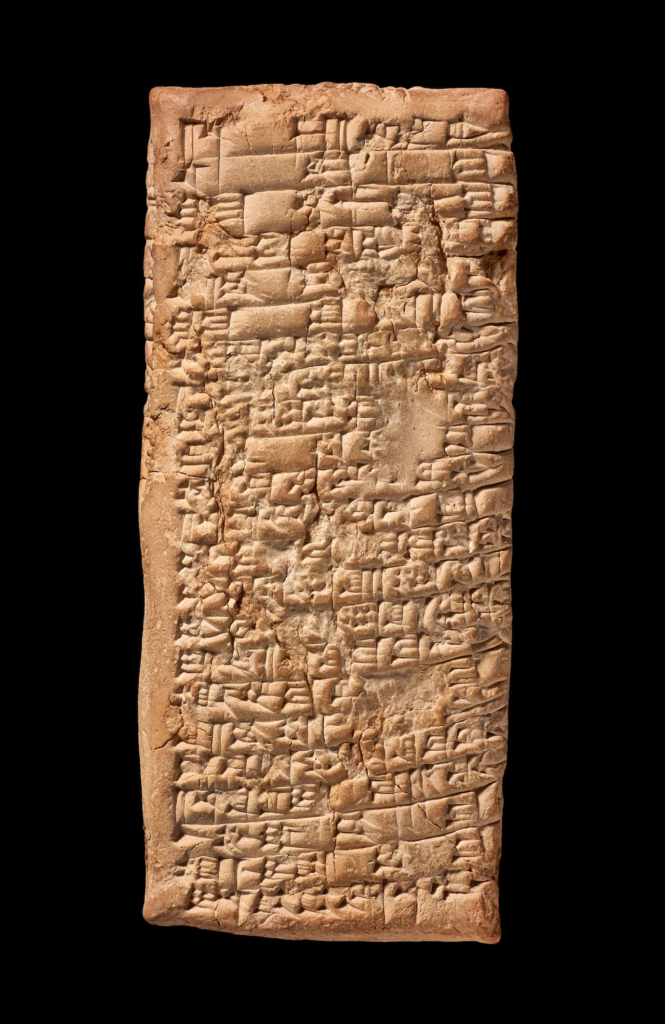The next time you find yourself composing an angry email to customer service, take comfort in knowing you’re participating in a tradition nearly four millennia old. Long before Yelp reviews and Twitter rants, an irate customer named Nanni etched his frustrations into clay, creating what would become the world’s oldest documented customer complaint. His target? A copper merchant named Ea-Nasir, whose poor-quality products and worse attitude earned him the dubious honor of history’s first thoroughly documented bad businessman.

Ea-Nasir and the World’s First Recorded Customer Complaint
Discovered in the ancient city of Ur in modern-day Iraq, this palm-sized clay tablet from around 1750 BCE now holds the Guinness World Record for the oldest customer complaint. The tablet’s journey from ancient Mesopotamia to the British Museum began with Sir Leonard Woolley’s expedition between 1922 and 1934. Archaeologists unearthed what they believed to be Ea-Nasir’s house. They found a collection of business correspondence that would make any modern customer service representative cringe.
The complaint itself reads like a particularly spicy email, only carved in Akkadian cuneiform instead of typed in ALL CAPS. Nanni begins with what might be history’s first “per my previous email” moment: “When you came, you said to me: ‘I will give fine quality copper ingots.'” What follows is a masterclass in passive-aggressive business correspondence, ancient Mesopotamian style.
Nanni’s grievances are threefold: the copper was substandard, his messenger was treated with contempt, and his money was withheld. The kicker comes near the end when Nanni declares, “I shall exercise against you my right of rejection because you have treated me with contempt!” It’s the Bronze Age equivalent of “I’d like to speak to your manager,” complete with a threat to take his business elsewhere.
Who Were Ea-Nasir and Nanni?
Ea-Nasir emerges from the historical record as something of a prototype for the unscrupulous businessman. Based in Ur but trading in Dilmun (modern-day Bahrain), he operated what we might today call an import-export business, specializing in copper. The discovery of multiple complaint tablets in what appears to be his house suggests that poor customer service might have been his signature business strategy.
Nanni, our aggrieved customer, appears to have been no small-time buyer. His complaint mentions delivering 1,080 pounds of copper to the palace on Ea-Nasir’s behalf, suggesting he was a significant player in the local business community. His messenger, caught in the middle of this ancient commercial dispute, was apparently a “gentleman” of similar social standing to both parties – making Ea-Nasir’s dismissive treatment all the more shocking.
Ancient Mesopotamian Trade and the Value of Copper
To understand why copper could inspire such passion, we need to consider the economics of Bronze Age Mesopotamia. Ur, situated on the Persian Gulf, was a crucial hub in a vast trading network that stretched across what we now call the Middle East. However, the city lacked local metal resources, forcing merchants to source their copper from Dilmun, more than 600 miles away.

This long-distance trade required significant capital investment. Merchants often formed partnerships, pooling resources to finance overseas purchases. These ventures would trade in various commodities – silver, copper, even sesame oil – and were subject to palace taxes and temple tithes. Professor Lloyd Weeks of the University of New England points out that this system represents one of the earliest examples of economic globalization, albeit on a regional scale.
Ea-Nasir’s Bad Business Reputation in Ur
Nanni wasn’t alone in his frustration with Ea-Nasir. Other surviving tablets paint a picture of a merchant whose reputation for delivering substandard copper was well-known throughout Ur. One tablet from a certain Imgur-Sin pleads, “Give him good copper, so that I will not become upset! Do you not know that I am weary?” Another, from a trader named Nar-am, specifically requests “very good copper,” suggesting Ea-Nasir’s tendency to palm off inferior goods was common knowledge.
Remarkably, we even have Ea-Nasir’s side of the story – or at least a glimpse of it. In one surviving tablet, he advises some associates not to “be critical” or “fear” when certain individuals come asking about missing metal. It’s the ancient equivalent of “Nothing to see here, folks!”
The archaeological context adds another layer to the story. Archaeologists found the tablets in what appears to be Ea-Nasir’s house, suggesting he actually kept his hate mail – perhaps as documentation of outstanding disputes, or maybe he just appreciated the drama. Either way, his filing system has preserved these complaints for nearly four thousand years.

The Enduring Legacy of Ea-Nasir’s Complaint Tablet
The tablet’s enduring fame owes much to its startling relatability. The complaints Nanni raises – poor quality goods, bad customer service, withheld payments – could have been written yesterday. It reminds us that while technology and society have advanced tremendously, human nature remains remarkably consistent.
This ancient tablet has found new life in the digital age, inspiring countless memes, comics, and social media posts. There’s something deeply satisfying about knowing that people four thousand years ago dealt with the same customer service frustrations we face today. The tablet serves as a humorous reminder that some experiences are truly universal.
But beyond the humor, Ea-Nasir’s tablet offers valuable insights into both ancient and modern commerce. It demonstrates that concepts we consider modern – consumer rights, quality guarantees, professional reputation – have roots stretching back to the very beginnings of written history. The complex web of trade relationships, financial arrangements, and business accountability it reveals wouldn’t be entirely out of place in today’s business world.
Moreover, the tablet reminds us that documentation and written records have always been crucial to commerce. Whether carved in clay or posted on social media, the act of formally recording grievances serves both practical and social purposes. It’s a way to seek redress, warn others, and perhaps most importantly, let off steam about poor service.
Important Reminder from Ea-Nasir’s Complaint Tablet
As we navigate our own customer service challenges in the digital age, there’s something comforting about knowing we’re part of a tradition that stretches back four millennia. Nanni’s clay tablet serves as a reminder that while the methods of commerce have evolved dramatically, the basic dynamics of human business relationships remain surprisingly constant.
The next time you find yourself crafting a strongly worded email about poor service or substandard products, remember Nanni and his complaint to Ea-Nasir. Your complaint may not survive four thousand years, but you’re participating in one of humanity’s oldest traditions – the quest for quality products and decent customer service.
And somewhere, perhaps, Ea-Nasir’s spiritual descendants are still telling frustrated customers, “If you want to take them, take them; if you do not want to take them, go away!” Some things, it seems, never change.
Frequently Asked Questions About Ea-Nasir
Who was Ea-Nasir?
Ea-Nasir was a copper merchant in ancient Ur, Mesopotamia, infamous for being the subject of the world’s oldest documented customer complaint. Operating around 1750 BCE, he imported copper from Dilmun (modern Bahrain) and had a reputation for delivering poor quality goods.
What was the world’s oldest customer complaint about?
The complaint, written by a customer named Nanni, accused Ea-Nasir of delivering low-quality copper, treating his messenger with contempt, and withholding payment. The complaint was etched on a clay tablet in cuneiform script around 1750 BCE and represents the oldest known written customer grievance.
Where is the Ea-Nasir complaint tablet now?
The clay tablet documenting the complaint against Ea-Nasir is housed at the British Museum in London. It was discovered during excavations led by Sir Leonard Woolley between 1922 and 1934 in what archaeologists believe was Ea-Nasir’s home in ancient Ur.
What does Ea-Nasir’s story teach us?
It shows that issues like poor quality goods and bad service have frustrated customers for thousands of years, proving some business problems are timeless. The survival of Ea-Nasir’s “hate mail” also demonstrates the importance of written documentation in business disputes throughout human history.



